Raising some chicken sounds like a great idea, right? But if you know little about poultry other than that baby chicks are fuzzy and adorable, you might be scratching your head how you’re gonna feed them. No worries, this chicken feed guide has all the answers you’re looking for.
Chickens may be small, but they sure love to peck a lot! All that cluck, clucking costs them energy, to say nothing of growing feathers and making eggs.
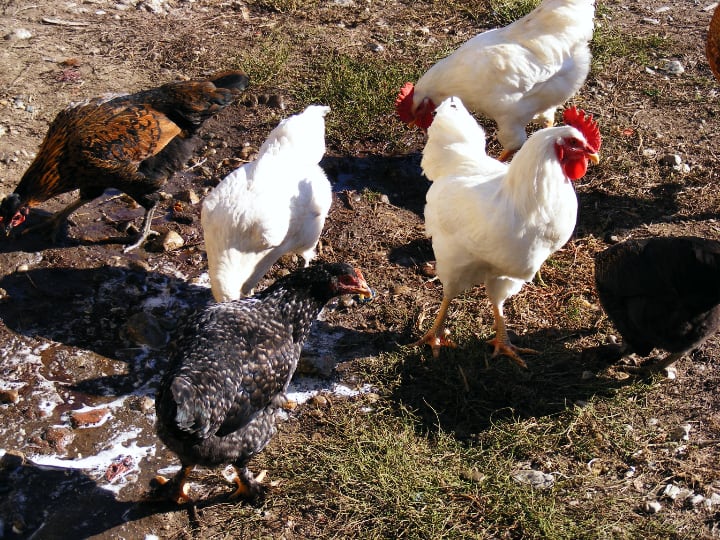
That’s why you want to take the question of chicken feed seriously. If you don’t, the eggs you gather won’t taste all that good!
In this guide, we’ll explain everything about chicken feed—starting with what little baby chicks need to the best diet for an egg-laying hen. You’ll learn about pellets, grit, scratch, and more.
By the time we’re done with you, you’ll feel like you’ve been a farmer for all your life. Well, almost.
What Is Chicken Feed?
Chicken feed is what makes the little guys keep quiet. And grow, of course. And thrive, if you feed them well.
Back in the day, feeding the chicken meant throwing them some grains to supplement whatever food they could forage around the farm.
Modern chicken feed is science-based, so they can get all the right amounts of proteins, minerals, and vitamins.
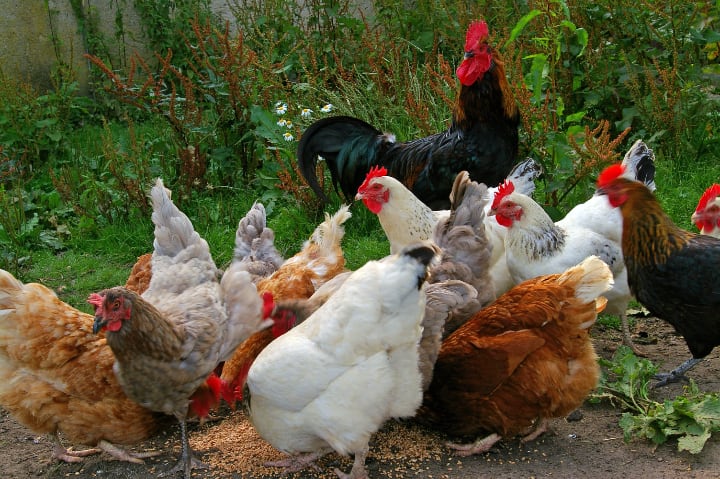
The quality of the eggs depends on the food your chickens eat. In other words, you need to pay attention to their dietary needs for every stage of their development.
Fun Fact: Did you know that a rooster announces to a flock of chickens that he’s found food with a “took, took, took” sound? But hens pretty much ignore him if they already know that there is food around.
Chicken Feed Terminology
If you don’t know what’s what, here are a few key terms about chicken feed. These refer mostly to how the different forms of chicken feed are served.
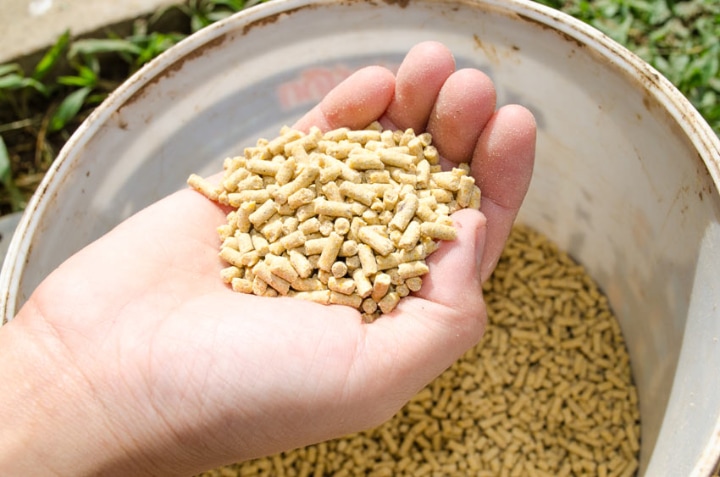
You will see these terms on the bags you can find in stores, so better pay attention!
- Pellets: This is your basic chicken feed made into pellets, obviously. It’s easier to handle and the compact shape is designed to reduce waste.
- Crumbles: The same food as in pellets, only in a different shape. Crumbles are easier to eat. They’re great for young hungry chicks or old hens.
- Mash: This is a loose, unprocessed form of chicken feed highly recommended for baby chicks as it is easier to digest. It’s actually a sort of powdered food which you can use as such or wet. Using hot water, you can prepare a sort of porridge most chicken love.
- Fermented: Any sort of chicken feed that’s mixed with water and allowed to ferment, which makes it easy to digest. Put some feed in a bucket and cover it with clean water. Leave for 48 hours, adding water from time to time, before you can serve it to your chicks.
Tip: You can feed your chicken with medicated food, which contains coccidiostat to protect them against coccidian parasites.
Basic Chicken Feed Requirements
If you want to keep your chicken happy and healthy, make sure that their food contains certain essential nutrients. These nutrients are not unlike the ones we need as humans, only scaled down to their size.
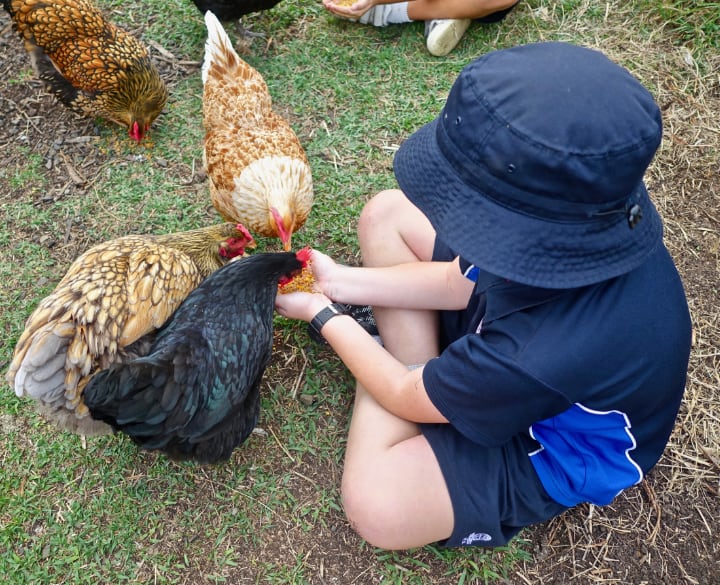
- Proteins: Essential for growth and muscle development; grains like oats, wheat, and corn are an excellent source of protein for all chicken types. You can also add to chicken feed proteins of animal origin, such as fishmeal.
- Vitamins: All the vitamins in the B group, which can be found in grains, but also vitamins A, D, and E. Vitamithis n A is essential for good egg production. Lack of vitamin D will result in thin eggshells, while vitamin B12 deficiency can cause poor growth, loss of appetite, and even nervous disorders!
- Trace minerals: Phosphorus, calcium, iron, and copper sulfate. Lack of calcium and phosphorus causes poor eggshell quality.
- Fiber: Essentially, fiber is needed “to keep things moving”. Birds use insoluble fiber as a gut filling to stimulate the movement of the gastrointestinal tract. Grains are an excellent source of fiber.
- Enzymes: These improve chicken’s ability to digest nutrients in the feed, which is why we regularly add them to chicken feed.
- Omega-3: Well, maybe chicken don’t really need this Omega-3, but the eggs they produce will have a higher content of this fatty acid, which you, the farmer, do need! So you’re doing yourself a favor by making sure the chicken feed has Omega-3 in it!
Fun Fact: A hen has to eat about four pounds of feed to make one dozen eggs.
Types of Chicken Feed
What type of chicken feed is best for your poultry depends primarily on their age. Little chicks have different dietary needs than egg-laying chicken, just as newborn babies need milk, not juicy steaks.
And don’t forget that some types of chicken eat more than others!
Starter Chicken Feed
For the first six weeks of their life, baby chicks need food that is rich in proteins to help them grow nice and healthy.
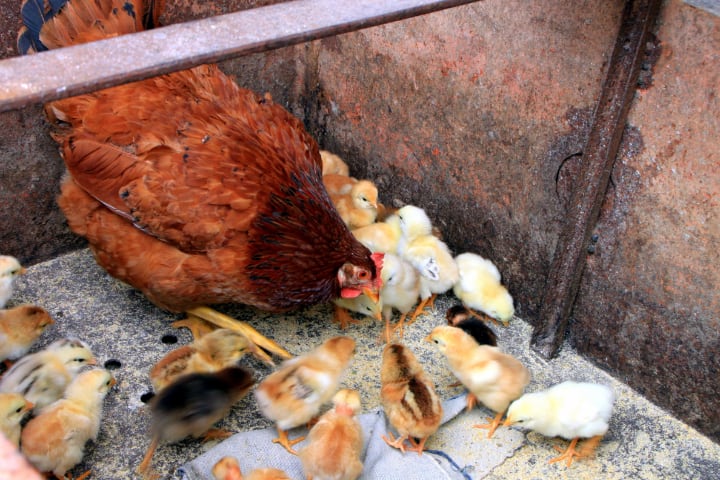
Starter chicken feed must have a 20-24% protein content, as well as carbohydrates, minerals, and vitamins.
Fact: Baby chicks need access to fresh water 24/7.
Grower Chicken Feed
Once they turn 6 (weeks) chicks become teenagers. Unlike moody human teenagers, chicken between 6-20 weeks will be perfectly happy if they’re well fed.
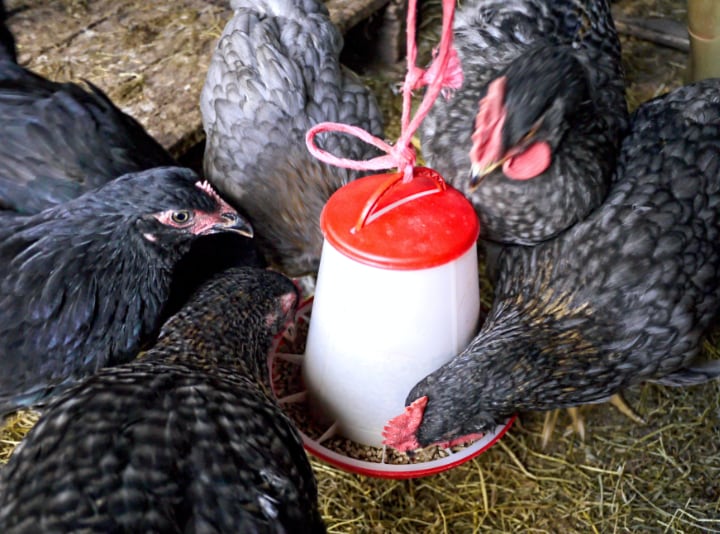
They need chicken feed with lower protein content, around 16-18%. Reducing protein content is important to protect the kidneys. They also need fewer vitamins and minerals than fast-growing baby chicks.
Tip: Small worms plucked after a rain shower are a great protein-packed chicken snack!
Layer Chicken Feed
When your birds hit 20 weeks or when they start laying eggs, they get promoted to grown-up chickens and have different dietary needs.
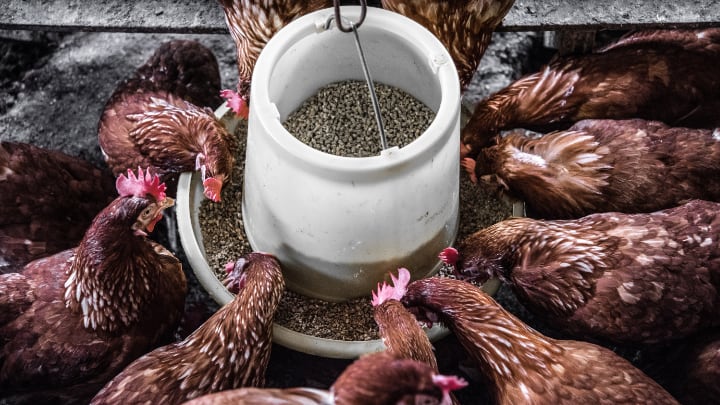
Fact: Did you know spring and summer are the best egg-laying seasons?
Layer chicken feed, which they will be eating for the rest of their lives, has the same protein content as grower chicken feed (16-18%), but a lot more calcium to make the egg-shells strong and crunchy.
Fun Fact: The record number of eggs laid by a chicken in one day is 7. The record number for eggs laid by a chicken in one year is 371.
Shell Grit
Chicken need grit (sand and small pebbles) to break down the food in the gizzard.
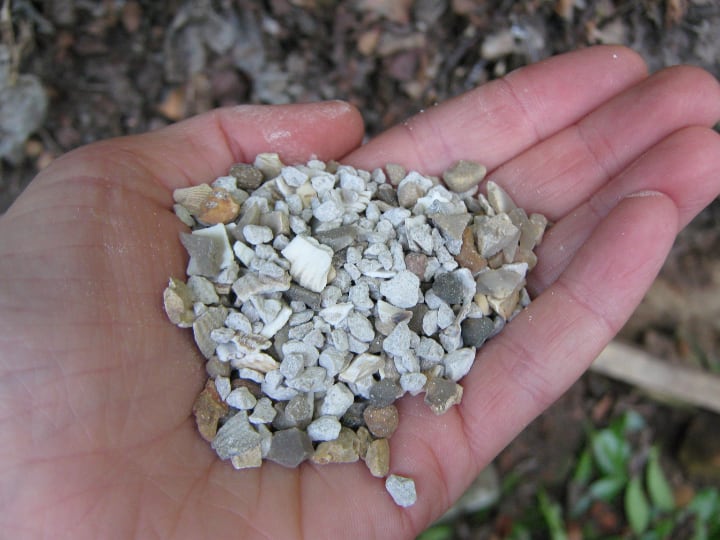
Adding ground-up oyster shells/cockle shells, egg shells, and/or limestone to the regular chicken feed is an important calcium source, and it helps their digestive system.
Tip: Providing a feeder full of ground oyster shells will keep your chicken happy and healthy!
Chicken Scratch
Chicken scratch is basically giving your chicks a treat when they behave themselves.
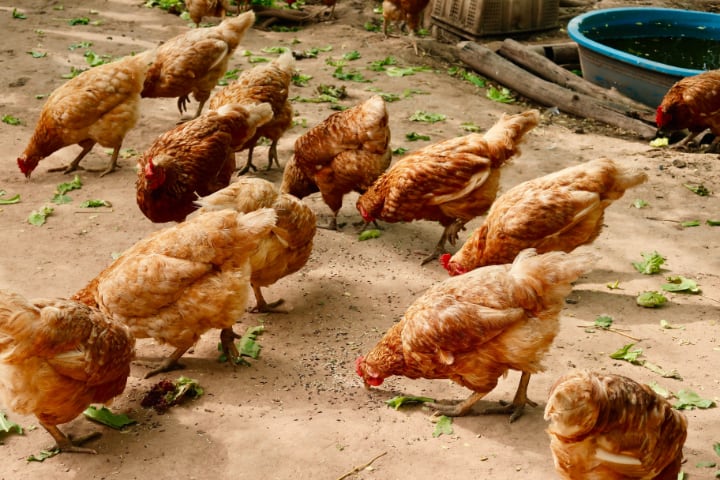
Not as nutritious as regular chicken feed, but much appreciated because scratch contains mostly seeds such as corn, barley, oats, wheat, sunflower seeds, milo, and millet.
Important: Scratch has a less-than-ideal protein content so don’t give to them every day.
Organic Chicken Feed
Just as the name says, organic chicken feed is free from pesticides, hormones, antibiotics, and other chemicals.
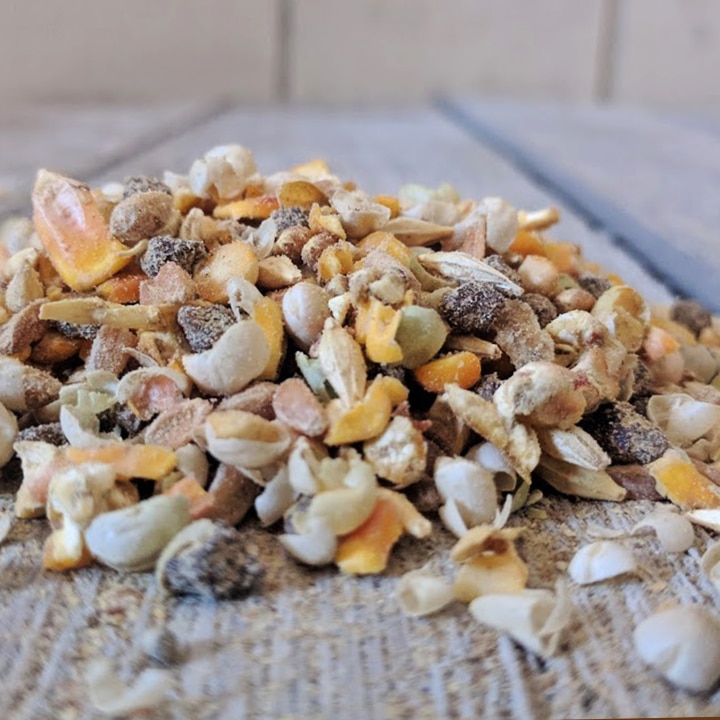
In other words, it’s usually the healthiest chicken feed you can give your birds, provided that it has the right amount of protein and nutrients.
Important: All the ingredients in organic chicken feed—wheat, barley, peas, flaxseed meal, corn, soybeans, molasses fish meal, etc. must be certified as organic for the feed to be truly organic. Read the labels carefully!
How to Make Your Own DIY Chicken Feed
Why make your own chicken feed? It’s cheaper than buying it and safer as you know exactly what’s in it! And it’s not that complicated.
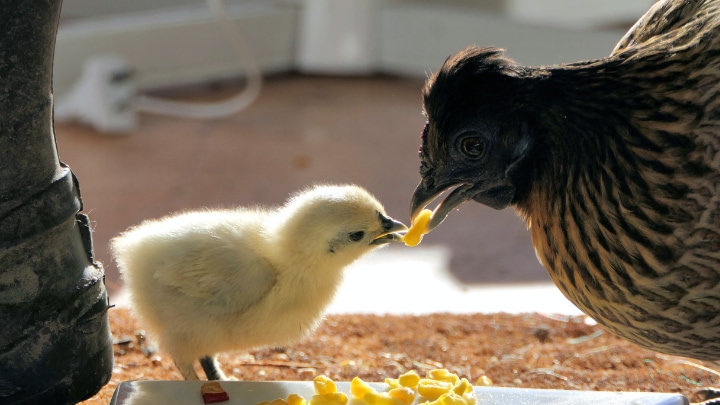
Buy the ingredients in bulk and store them in a dark cool place. Once you have all the ingredients, mix them, and prepare some food bags in advance, as you definitely won’t want to spend time every day making lunch for your flock, right?
Tip: Make sure to store DIY feed in a bin with a tight bin, to keep rodents away. Never prepare very large quantities! Stored for a long period of time, chicken feed can get moldy and you’ll have to throw it away.
Equipment You’ll Need
Maybe equipment is too big a term, the whole process is really easy. All you really need is:
- Grinder
- Sacks
- Storage bin
If you have a big farm with lots of chicken, you will probably need a commercial-strength grinder.
What to Put in Your Chicken Food
Chickens were meant to feed on grains and whatever they could find: worms, grass, pebbles. They’re easy to please and they can thrive on a grain-based diet.
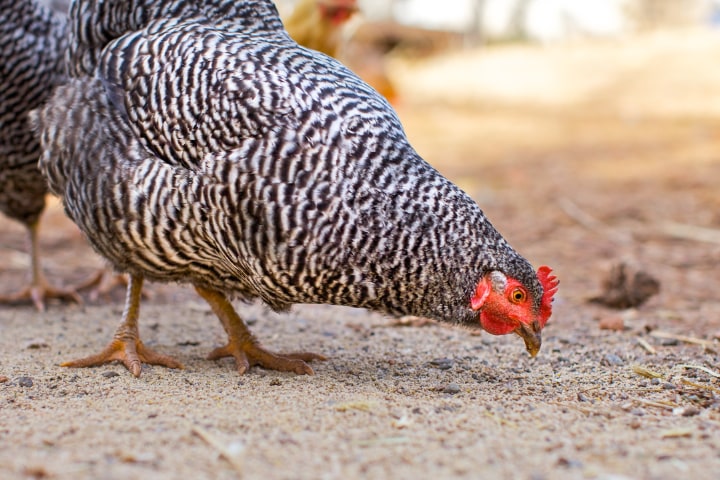
The percentages shown below are estimates. Your chickens will be perfectly fine if they get more corn one day or a bit more peas the next one.
Just make sure their diet is varied enough so they can get all the essential nutrients.
Essential DIY Chicken Feed Ingredients
- Corn 30%
- Wheat 30%
- Peas 20%
- Oats 10%
- Fish Meal 10%
Additional DIY Chicken Feed Ingredients
- Kelp – this is a great source of vitamins, minerals, amino acids and carbohydrates
- Poultry Nutri Balancer – a vitamins and minerals supplement your chicken need
- Aragonite – this mineral found as deposits in hot springs is another calcium source
- Ground eggshell – this is the cheapest calcium supplement (you can grind the shells in a coffee grinder)
- Shell Grit
Fact: Did you know that chicken can taste saltiness, but not sweetness? No point in offering them candy then!
Best Chicken Feed
There are many types of chicken feed out there so it can be very hard to choose.
Since you cannot take your chicks to the store and ask them to pick one but must keep them in your DIY chicken coop, here are a few examples of good chicken food to get you started.
Scratch and Peck Feeds
This counts as gourmet food for your chicken (and ducks, if you have them), and it’s a certified organic, soy-free chicken feed for your egg-laying hens.
K Kalmbach Feeds
This product was specially created for baby chicks, but you can also use it to feed chicken up to 16 weeks old. It’s enriched with probiotics and amino acids for a healthy digestive system.
Prairie’s Choice
Nutritious wholesome food, best recommended for a teenage chicken to help them grow and start laying eggs. If you like letting your chickens loose, this one can help you keep them off the lawn.
Fun Fact: Pecking order is a real thing in the chicken world. The top chickens literally peck weaker ones and can keep them away from the feeding trough, which is why you should always provide plenty of food to go around.
Chicken Feed FAQ
What is the best feed for chickens?
The best chicken feed is a balanced one, with all the recommended proteins, fiber, vitamins, and so on. It doesn’t matter if you buy it or make it yourself as long as it has the right ingredients. Always keep in mind the age of the chicken, as their dietary needs vary with age. If you notice a change in your chickens’ appetite, best talk to a vet.
How much does a chicken eat per day?
Many farmers say chickens would eat from sunup to sundown, but if you want a definitive answer, an egg-laying hen needs 1/4 pound of chicken feed per day. You can feed them several times a day, or use the free-feed method, providing them enough food to eat whenever they want.
How long does a 50 lb bag of chicken feed last?
Since a chicken eats 1/4 pound per day, on average, a standard 50lb bag should last for 200 days. However, simple math doesn’t take into account waste or the considerable damage some hungry rodents might do if they get to your food supplies. Tip: Consider investing in a special no-waste chicken feeder to minimize spilled seeds.
What can I feed my chickens other than chicken feed?
Before chicken feed was invented, backyard chicks would regularly get leftovers from the farmer’s table. You can safely feed your chicken—fruit and veggies (carrots, squash, beans cauliflower, spinach, bananas, or berries), but they won’t mind the occasional cooked rice. For calcium, you can give them cheese and yogurt.
Peckish, But Not Picky
Chicken sure love to peck and they’re always a bit peckish, but they sure aren’t picky when it comes to food. If you’re a beginner, it’s probably best to start with store-bought chicken feed and always make sure it is appropriate for their age.
In case you run out, don’t panic—a handful of grains and some scraps will keep them full till you get a chance to run to the store.
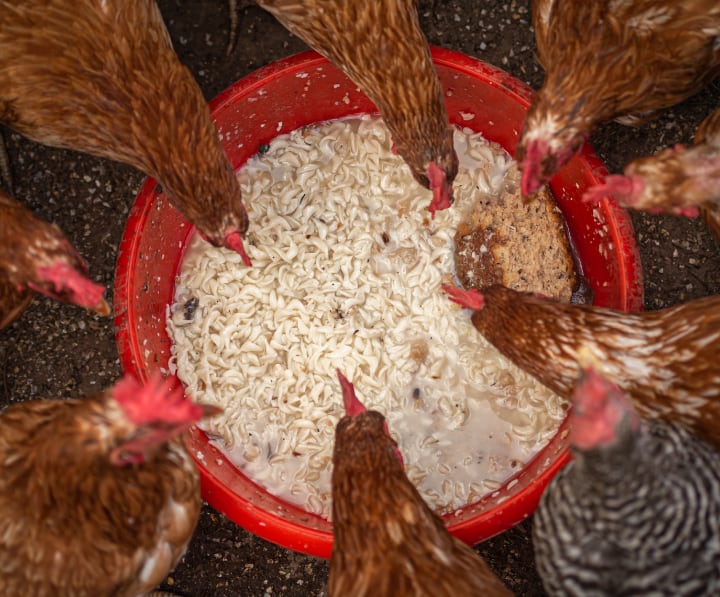
However, if you’re concerned about the quality of their food, you should seriously consider going the homesteader way and make your own chicken feed, especially if you have a small flock and the eggs are mainly for your family’s consumption.
If your chickens have proper food, your family will have proper food, too!
By now we hope we have enlightened you a bit on the rather peckish topic—not!—of chicken feed. Why not be a good neighbor and show this guide to friends and neighbors who you think may need it?
Don’t forget to read more about mealworms. They can be an excellent food for your chickens too!
That way we can improve together the global chicken diet, right?

Leave a Reply